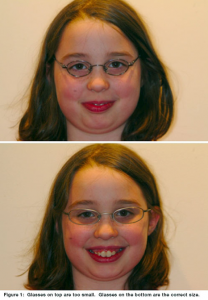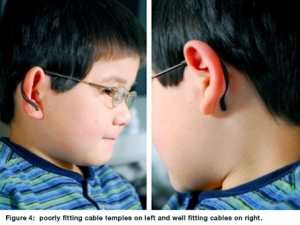What type of lenses should be used?
Polycarbonate (shatter proof) lenses are the ONLY type of lenses that should be prescribed to children unless your physician tells you differently. Polycarbonate lenses have built in U.V. protection to block harmful rays from the sun, they are light in weight and work well with strong prescriptions, and come with an anti-scratch coating.
Which optical shop is best?
Optical shops that frequently work with children are preferable. If frames and lenses are not fit properly, the endeavor of having a child wear glasses may be severely compromised. These optical shops also often have a superior selection of children’s frames. Your local independent optician will work with your doctor to ensure proper power and continued good fit for your child.
Ask your optical shop about any frame or lens warranty that is available. If there is a warranty available, be sure to ask what it covers. Most warranties do not cover lost glasses.
What frame should be chosen?
Size is very important. (Figure 1) Glasses must fit well so that they are comfortable and provide clear vision. If uncomfortable, a child may be reluctant to wear spectacles. Children should not be given adult frames to grow into. Some children wear straps to help keep glasses in place. Every child has a unique face and frames should be chosen to fit appropriately. One size does not fit all. Remember that your child will spend most waking hours wearing his or her glasses. Quality glasses will not only hold up better, but will be more comfortable for your child. The frame should be adjusted as needed for comfort and alignment on your child’s face.

Frames should preferably not touch the cheeks or eye lashes and the eyes should be centered in the lenses. The frame and nose pads can be adjusted for optimal fit. (Figure 2)

The horizontal line on bifocal lenses should go through the middle or immediately below the pupil (significantly higher than the typical bifocal position in adult glasses). (Figure 3)

Glasses for infants and toddlers often come with cable temples.(Figure 4) This type of temple wraps around the ear. It is important that the cable not be too tight or the temple length too short. Children can grow out of cable frames very quickly, so ask about silicone temple tips for glasses as they work the same way as cables but are adjustable.

Do children love glasses as soon as they get them?
Nearsighted (myopic) children often enjoy their glasses immediately. However, far-sighted (hyperopic) and astigmatic children may take several weeks to adjust to wearing spectacles. If the child does not cooperate, the doctor may prescribe eye drops in an attempt to help the child adjust to the glasses.
How do I care for glasses?
When not being worn, glasses should be placed in a case and should never be placed face down on a surface for fear of scratching the lenses. The motto for children is “Glasses stay on your face or they go in your case”. Lenses may be cleaned with a soft cotton cloth or a special “lens cloth”. If the frames are bent or do not fit well, take them to your optical shop for an adjustment. Do not try to adjust the frame yourself as breakage may occur.
Credits: Journal of American Association for Pediatric Ophthalmology and Strabismus